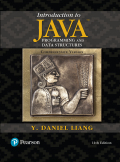
SetOperation.java
Program Plan:
- Include the class name named “SetOperation”.
- Import java array class from util package.
- Import java linkedhash set class from util package.
- Import the set interface.
- Define class.
- Declare the main()method.
- Create linked list Hash set set1 and assign name of person as values.
- Create another linked list Hash set set2 and assign name of person as values.
- Display the union of the two sets set1 and set2 using addAll() function and print the result.
- Display the difference of the two sets by calling the removeAll function and print the result.
- Display the intersection of the two sets and print the result.
- Close the main method.
- Close the class “SetOperation”.
The below java code to create two sets and assign person’s name to them and then perform set union, difference and intersection of the two sets.
Explanation of Solution
Program:
//import java array class from util package
import java.util.Arrays;
//import java linkedlist hash set class from util package
import java.util.LinkedHashSet;
//import the set interface
import java.util.Set;
//class Definition
public class SetOperation {
// main method
public static void main(String[] args) {
/* create linked list hash set Set1 and assign name of person as values */
Set<String> set1 = new LinkedHashSet<>(Arrays.asList("George", "Jim",
"John", "Blake", "Kevin", "Michael"));
/*Create another linked list hash set Set2 and assign name of person as values */
Set<String> set2 = new LinkedHashSet<>(Arrays.asList("George", "Katie","Kevin", "Michelle", "Ryan"));
/* Display the union of the two sets set1 and set2 using addAll function */
Set<String> union = new LinkedHashSet<>(set1);
union.addAll(set2);
// print the union results
System.out.println("Union of the two sets: " + union);
/* Display the difference of the two sets by calling the removeAll function
*/
Set<String> difference = new LinkedHashSet<>(set1);
difference.removeAll(set2);
// print the difference of two sets
System.out.println("Difference of the two sets: " + difference);
// Display the intersection of the two sets
Set<String> intersection = new LinkedHashSet<>();
/*
Check for the elements that are present in set 2 and also present in
* set 1
*/
for (String e : set2) {
if (set1.contains(e))
intersection.add(e);
}
// print the intersection of two sets
System.out.println("Intersection of the two sets: " + intersection);
}
}
Union of the two sets: [George, Jim, John, Blake, Kevin, Michael, Katie, Michelle, Ryan]
Difference of the two sets: [Jim, John, Blake, Michael]
Intersection of the two sets: [George, Kevin]
Want to see more full solutions like this?
Chapter 21 Solutions
Introduction to Java Programming and Data Structures Comprehensive Version (11th Edition)
- Could you help me to know features of the following concepts: - commercial CA - memory integrity - WMI filterarrow_forwardBriefly describe the issues involved in using ATM technology in Local Area Networksarrow_forwardFor this question you will perform two levels of quicksort on an array containing these numbers: 59 41 61 73 43 57 50 13 96 88 42 77 27 95 32 89 In the first blank, enter the array contents after the top level partition. In the second blank, enter the array contents after one more partition of the left-hand subarray resulting from the first partition. In the third blank, enter the array contents after one more partition of the right-hand subarray resulting from the first partition. Print the numbers with a single space between them. Use the algorithm we covered in class, in which the first element of the subarray is the partition value. Question 1 options: Blank # 1 Blank # 2 Blank # 3arrow_forward
- 1. Transform the E-R diagram into a set of relations. Country_of Agent ID Agent H Holds Is_Reponsible_for Consignment Number $ Value May Contain Consignment Transports Container Destination Ф R Goes Off Container Number Size Vessel Voyage Registry Vessel ID Voyage_ID Tonnagearrow_forwardI want to solve 13.2 using matlab please helparrow_forwarda) Show a possible trace of the OSPF algorithm for computing the routing table in Router 2 forthis network.b) Show the messages used by RIP to compute routing tables.arrow_forward
- using r language to answer question 4 Question 4: Obtain a 95% standard normal bootstrap confidence interval, a 95% basic bootstrap confidence interval, and a percentile confidence interval for the ρb12 in Question 3.arrow_forwardusing r language to answer question 4. Question 4: Obtain a 95% standard normal bootstrap confidence interval, a 95% basic bootstrap confidence interval, and a percentile confidence interval for the ρb12 in Question 3.arrow_forwardusing r languagearrow_forward
 C++ Programming: From Problem Analysis to Program...Computer ScienceISBN:9781337102087Author:D. S. MalikPublisher:Cengage Learning
C++ Programming: From Problem Analysis to Program...Computer ScienceISBN:9781337102087Author:D. S. MalikPublisher:Cengage Learning New Perspectives on HTML5, CSS3, and JavaScriptComputer ScienceISBN:9781305503922Author:Patrick M. CareyPublisher:Cengage Learning
New Perspectives on HTML5, CSS3, and JavaScriptComputer ScienceISBN:9781305503922Author:Patrick M. CareyPublisher:Cengage Learning Systems ArchitectureComputer ScienceISBN:9781305080195Author:Stephen D. BurdPublisher:Cengage Learning
Systems ArchitectureComputer ScienceISBN:9781305080195Author:Stephen D. BurdPublisher:Cengage Learning EBK JAVA PROGRAMMINGComputer ScienceISBN:9781337671385Author:FARRELLPublisher:CENGAGE LEARNING - CONSIGNMENTProgramming Logic & Design ComprehensiveComputer ScienceISBN:9781337669405Author:FARRELLPublisher:Cengage
EBK JAVA PROGRAMMINGComputer ScienceISBN:9781337671385Author:FARRELLPublisher:CENGAGE LEARNING - CONSIGNMENTProgramming Logic & Design ComprehensiveComputer ScienceISBN:9781337669405Author:FARRELLPublisher:Cengage





